Navigation
Implementation of Crucial Steps to Protect and Preserve Oceans
- birds
- Callum Roberts
- coral reefs
- fisheries
- global call to action
- island ecosystems
- National Climate Assessment
- oceans
- Pacific Remote Islands Marine National Monument
- President Barack Obama
- Secretary of State John Kerry
- south-central Pacific Ocean
- Sylvia Earle
- Biodiversity
- Global Climate Change
- Oceans, Coral Reefs
- Water
Expanded protections near the Pacific Remote Islands Marine National Monument in the south-central Pacific Ocean will add to the Pacific Marine Protected Areas, Marine National Monuments, designated by President George W. Bush, and the declaration of the Phoenix Islands a protected area to ensure its biological diversity and sustainability by small Pacific Island nation of Kiribati.
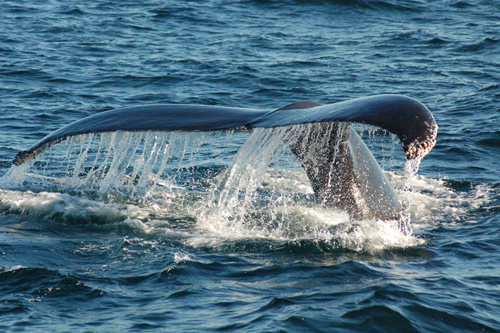 Humpback whale tail is displayed as animal dives in Stellwagen Bank National Marine Sanctuary.: In the Pacific, humpbacks migrate seasonally from Alaska to Hawaii--they can complete the 3,000 mile (4,830 km) trip in as few as 36 days! Text and Photograph courtesy of NOAA
Humpback whale tail is displayed as animal dives in Stellwagen Bank National Marine Sanctuary.: In the Pacific, humpbacks migrate seasonally from Alaska to Hawaii--they can complete the 3,000 mile (4,830 km) trip in as few as 36 days! Text and Photograph courtesy of NOAA
Roll on, thou deep and dark blue Ocean, roll!
Ten thousand fleets sweep over thee in vain:
Man marks the earth with ruin, his control
Stops with the shore…
With these words from Lord Byron’s, “Childe Harold’s Pilgrimage,” marine scientist Callum Roberts at the university of York in England fittingly opens his book, The Ocean of Life: The Fate of Man and the Sea.
Today, the oceans are in deep peril with onslaughts from every sector -- land, air and sea -- so much so that not only are species are being killed in unfathomable numbers, but those that survive the onslaught of climate change are gravitating to new habitats.
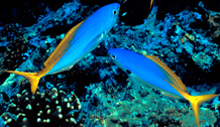 Caesio fusilier, A fast moving fish needing much swimming space and very good water movement.: Photograph courtesy of US Fish and Wildlife ServiceThey must move, as Roberts explains, as “the climate changes [because] their physiology is tuned to temperature. Enyzmes that regulate bodily processes work best within a relatively narrow range of temperatures, and species suffer when those limits are breached. But there are other reasons. Species need food and habitat, and these are undergoing their own moves. In the North Sea, for example, many kinds of microscopic plankton that drift in open water have shifted north over the last forty years.”
Caesio fusilier, A fast moving fish needing much swimming space and very good water movement.: Photograph courtesy of US Fish and Wildlife ServiceThey must move, as Roberts explains, as “the climate changes [because] their physiology is tuned to temperature. Enyzmes that regulate bodily processes work best within a relatively narrow range of temperatures, and species suffer when those limits are breached. But there are other reasons. Species need food and habitat, and these are undergoing their own moves. In the North Sea, for example, many kinds of microscopic plankton that drift in open water have shifted north over the last forty years.”
In a plea for the urgency to curtail emissions, Callum writes, “Not for fifty-five million years has there been a disruption of comparable severity to the calamity that lies just a hundred years ahead if we fail to curtail emissions fast.
“By absorbing heat the oceans have so far spared us the worst of global warming. But warming seas have set life on the move, so in the years to come the fortunes of some fishing nations will wane as others rise. But warming will have far more grave effects on productivity, driving it to excess in some places while turning others into oceanic deserts.”
Such concern about the consequences of climate change on oceans was expressed in the recently released the United States National Climate Assessment which “confirms that climate change is causing sea levels and ocean temperatures to rise.”
 Masked boobies nest on small tropical islands, especially ones that are flat and without forests. They spend the rest of their: time at sea. Photograph courtesy of USFWS
Masked boobies nest on small tropical islands, especially ones that are flat and without forests. They spend the rest of their: time at sea. Photograph courtesy of USFWS
The Assessment says, “Changing temperatures can harm coral reefs and force certain species to migrate. In addition, carbon pollution is being absorbed by the oceans, causing them to acidify, which can damage coastal shellfish beds and reefs, altering entire marine ecosystems. In fact, the acidity of our ocean is changing 50 times faster than any known change in millions of years. And black market fishing—fishing that is illegal, unreported, and unregulated (IUU)—continues to pose a major threat to the sustainability of our world’s fisheries, economies and to global security.”
In 2010, President Barack began significant actions to address concerns about the health of our oceans and other bodies of water when he signed an Executive Order establishing a National Policy for the Stewardship of the Ocean, Coasts, and Great Lakes. That Executive Order adopts the Final Recommendations of the Interagency Ocean Policy Task Force and directs Federal agencies to take the appropriate steps to implement them.
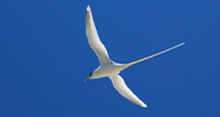 White-tailed Tropicbird: Mostly white except for a narrow black eye patch and black streak on upper wings;: long, narrow, white central tail feathers. Photograph courtesy of USFWS
White-tailed Tropicbird: Mostly white except for a narrow black eye patch and black streak on upper wings;: long, narrow, white central tail feathers. Photograph courtesy of USFWS
As part of an “Our Ocean” international conference on sustainable fisheries, marine pollution, and ocean acidification hosted by the US State Department that concluded on 17 June 2014, Secretary of State John Kerry issued a global call to action to protect the oceans and President Obama announced steps that the United States is taking to answer that call.
Among them, President Obama announced a commitment to use his authority “to protect some of our most precious marine landscape just like he has for the nation’s mountains and rivers and forests.” In order to meet his commitment, “the Administration will immediately consider how it can expand protections near the Pacific Remote Islands Marine National Monument in the south-central Pacific Ocean, an area which contains some of the most pristine tropical marine environments in the world.
 Red-tailed Tropicbird Mostly white except for partial black eye ring and short eye line, black shafts of outer wings;: long, narrow, tail feathers with red shafts. Photograph courtesy of USFWS
Red-tailed Tropicbird Mostly white except for partial black eye ring and short eye line, black shafts of outer wings;: long, narrow, tail feathers with red shafts. Photograph courtesy of USFWS
These tropical coral reefs and associated marine ecosystems are also among the most vulnerable areas to the impacts of climate change and ocean acidification. Before making decisions about the geographic scope and details of future marine protections, we will consider the input of fishermen, scientists, conservation experts, elected officials, and other stakeholders. The President is also calling on other world leaders to join him in this effort to ensure that the world’s most valuable ocean ecosystems remain productive and pristine for our children and grandchildren.”
“We’ve already shown that when we work together, we can protect our oceans for future generations,” said President Obama. “So let’s redouble our efforts. Let’s make sure that years from now we can look our children in the eye and tell them that, yes, we did our part, we took action, and we led the way toward a safer, more stable world.”
Expanded protections near the Pacific Remote Islands Marine National Monument in the south-central Pacific Ocean will add to the Pacific Marine Protected Areas, Marine National Monuments, designated by President George W. Bush, and the declaration of the Phoenix Islands a protected area to ensure its biological diversity and sustainability by small Pacific Island nation of Kiribati.
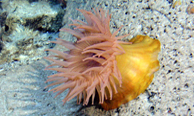 Corallimorphus / Sea Anemone: These beautiful marine animals with wavy tentacles, resemble underwater flowers.: Fish, snails or crabs that blunder into these waving fronds are soon paralysed by the stinging tentacles, engulfed by the central mouth and digested. Photograph courtesy of USFWSActions to Protect and Preserve the Ocean Include:
Corallimorphus / Sea Anemone: These beautiful marine animals with wavy tentacles, resemble underwater flowers.: Fish, snails or crabs that blunder into these waving fronds are soon paralysed by the stinging tentacles, engulfed by the central mouth and digested. Photograph courtesy of USFWSActions to Protect and Preserve the Ocean Include:
Establishing a pathway to new marine sanctuaries. Last week, the National Oceanic and Atmospheric Administration (NOAA) released a final rule re-opening the public nomination process for proposing new sanctuaries in our oceans and Great Lakes. For the first time since 1995, Americans will be able to nominate nationally significant marine and Great Lakes areas as marine sanctuaries. This reflects the overwhelming consensus of more than 18,000 comments NOAA received on the proposed version of the rule and will give local communities and organizations the opportunity to voice their support for significant marine areas in need of protection.
See: NOAA announces updated process for nominating new national marine sanctuaries: Public can now suggest locations for consideration: available at http://www.noaanews.noaa.gov/stories2014/20140610_sanctuary_nomination.html
Combating black market fishing and supporting fishermen. The President is directing Federal agencies to develop a comprehensive program aimed at deterring illegal fishing, addressing seafood fraud, and preventing illegally caught fish from entering the marketplace by increasing traceability and transparency. Black market fishing constitutes up to 20 percent of the wild marine fish caught each year around the world, and drains up to $23 billion from legitimate fishing enterprises. The program will be an important step in ending illegal, unreported, and unregulated fishing, building the market for legally and sustainably caught seafood, and supporting the men and women of the fishing industry.
Additional news from the White House Fact Sheet:
In addition, the Administration is taking steps to protect coastal communities from the impacts of climate change, improve domestic aquaculture, and providing research to better understand the challenges facing our oceans.
· Meeting diverse coastal needs with regional marine planning. Under the President’s National Ocean Policy, voluntary marine planning bodies are working all over the country to find commonsense ways for the wide range of people and organizations who live, work, and play in the ocean to enjoy the full benefits of its resources. Regional marine plans help balance coastal use issues including fishing, energy, and marine transportation with the interests of communities, ensuring maximum benefits for all. Last week, the Administration announced that the Northeast and Mid-Atlantic regional marine planning bodies will have their plans out the door by the end of the President’s term. This will allow fishing and coastal communities from Maine to Virginia to meet diverse needs and establish priorities for the use of their ocean areas, while making them less vulnerable to economic shocks and the resilience of climate change.
· Understanding the impacts of ocean acidification. Today, [17 June 2014] the White House Office of Science and Technology Policy is releasing a white paper on ocean acidification, summarizing current scientific knowledge about this key challenge, its relationship to climate change, and its impacts on society, as well as highlighting key steps the Obama Administration is taking to better understand the problem and potential solutions.
· $102 million to build resilience in coastal communities. Yesterday, [16 June 2014] the Department of the Interior announced $102 million in competitive grants funding science-based solutions to restore flood plains and natural barriers, such as marshes and wetlands along the Atlantic Coast. The funded projects will help deliver on the Administration’s Climate Action Plan commitment to make local communities more resilient against future storms.
· Bolstering domestic shellfish aquaculture. Federal agencies are completing work on a new roadmap to streamline the permitting process for shellfish aquaculture. The roadmap will help shellfish farmers understand how to secure the permits they need and will help federal agencies identify ways to improve efficiency in the permitting process. By removing barriers in the permitting process, the United States can encourage shellfish farming and help rebalance our seafood trade. Currently, most seafood consumed in the U.S. is imported, resulting in a seafood trade deficit of between $8 and $10 billion a year. Farming more shellfish will also be an economic boon to local communities, creating jobs and investment on our shores.
· National Strategic Plan for Federal Aquaculture Research. Aquaculture is an increasingly integral source of safe, nutritious, sustainable seafood for consumers in the United States and worldwide. Today, the interagency National Science & Technology Council’s Committee on Science is releasing a new National Strategic Plan for Federal Aquaculture Research to provide a framework for coordination and collaboration across agencies on research related to this important agricultural domain and to guide Federal agencies going forward as they prioritize their aquaculture-related research and development activities.
.jpg) Masked booby chick: The name "booby," originally coined by sailors, referred derogatorily to these birds': lack of fear around humans. Its feeding tactics are memorable: these dazzling white birds make high velocity plunge-dives in search of fish. US Fish and Wildlife Service
Masked booby chick: The name "booby," originally coined by sailors, referred derogatorily to these birds': lack of fear around humans. Its feeding tactics are memorable: these dazzling white birds make high velocity plunge-dives in search of fish. US Fish and Wildlife Service
Notes:
Global Call To Action is available at http://www.state.gov/r/pa/prs/ps/2014/06/227044.htm
For more information on the Our Ocean conference, visit http://www.state.gov/.
For more information on the President’s National Ocean Policy, visit http://www.whitehouse.gov/administration/eop/oceans.
About the National Ocean Council
The National Ocean Council is charged with implementing the National Ocean Policy. Membership of the NOC initially includes the following, with additional officers designated by the Co-Chairs as needed:
· The Secretaries of: State, Defense, the Interior, Agriculture, Health and Human Services, Commerce, Labor, Transportation, Energy, and Homeland Security
· The Attorney General
· The Administrators of: the Environmental Protection Agency (EPA) and the National Aeronautics and Space Administration (NASA)
· The Chairs of: The Council on Environmental Quality (CEQ), the Federal Energy Regulatory Commission (FERC), and the Joint Chiefs of Staff
· The Directors of: the Office of Management and Budget (OMB), National Intelligence, the Office of Science and Technology Policy (OSTP), the National Science Foundation (NSF)
· The Assistants to: the President for National Security Affairs, Homeland Security and Counterterrorism, Domestic Policy, Economic Policy, and Energy and Climate Change
· An employee of the United States designated by the Vice President
· The Under Secretary of Commerce for Oceans and Atmosphere (NOAA Administrator)
Related articles on the Horizon International Solutions Site Include:
President Obama signs Executive Order establishing a National Policy for the Stewardship of the Ocean, Coasts, and Great Lakes available at http://www.solutions-site.org/node/425
Kiribati Creates World’s Largest Marine Protected Area available at http://www.solutions-site.org/node/300.
Three Pacific Marine Protected Areas, Marine National Monuments, Established available at http://www.solutions-site.org/node/342
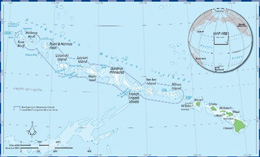 Map
Map
Largest Marine Conservation Area On Earth, Northwestern Hawaiian Islands Marine National Monument With Nearly 140,000 Square Miles, Created By President Bush Under Antiquities Act * available at http://www.solutions-site.org/node/204. (*Note: As of February 2008, with the establishment of the Kiribati preserve, it is now the second largest marine conservation area.)
 The Eastern Pacific Seascape spans Central and South America, covering a total of 2 million square kilometers.: Photograph© Kip Evans / Mission Blue (Cocos)Sylvia Earle Alliance’s Mission Blue and Partners Establish Ocean Hope Spots available at http://www.solutions-site.org/node/1162
The Eastern Pacific Seascape spans Central and South America, covering a total of 2 million square kilometers.: Photograph© Kip Evans / Mission Blue (Cocos)Sylvia Earle Alliance’s Mission Blue and Partners Establish Ocean Hope Spots available at http://www.solutions-site.org/node/1162
Search
Latest articles
Agriculture
- World Water Week: Healthy ecosystems essential to human health: from coronavirus to malnutrition Online session Wednesday 24 August 17:00-18:20
- World Water Week: Healthy ecosystems essential to human health: from coronavirus to malnutrition Online session Wednesday 24 August 17:00-18:20
Air Pollution
- "Water and Sanitation-Related Diseases and the Changing Environment: Challenges, Interventions, and Preventive Measures" Volume 2 Is Now Available
- Global Innovation Exchange Co-Created by Horizon International, USAID, Bill and Melinda Gates Foundation and Others
Biodiversity
- It is time for international mobilization against climate change
- World Water Week: Healthy ecosystems essential to human health: from coronavirus to malnutrition Online session Wednesday 24 August 17:00-18:20
Desertification
- World Water Week: Healthy ecosystems essential to human health: from coronavirus to malnutrition Online session Wednesday 24 August 17:00-18:20
- UN Food Systems Summit Receives Over 1,200 Ideas to Help Meet Sustainable Development Goals
Endangered Species
- Mangrove Action Project Collaborates to Restore and Preserve Mangrove Ecosystems
- Coral Research in Palau offers a “Glimmer of Hope”
Energy
- Global Innovation Exchange Co-Created by Horizon International, USAID, Bill and Melinda Gates Foundation and Others
- Wildlife Preservation in Southeast Nova Scotia
Exhibits
- Global Innovation Exchange Co-Created by Horizon International, USAID, Bill and Melinda Gates Foundation and Others
- Coral Reefs
Forests
- NASA Satellites Reveal Major Shifts in Global Freshwater Updated June 2020
- Global Innovation Exchange Co-Created by Horizon International, USAID, Bill and Melinda Gates Foundation and Others
Global Climate Change
- It is time for international mobilization against climate change
- It is time for international mobilization against climate change
Global Health
- World Water Week: Healthy ecosystems essential to human health: from coronavirus to malnutrition Online session Wednesday 24 August 17:00-18:20
- More than 400 schoolgirls, family and teachers rescued from Afghanistan by small coalition
Industry
- "Water and Sanitation-Related Diseases and the Changing Environment: Challenges, Interventions, and Preventive Measures" Volume 2 Is Now Available
- Global Innovation Exchange Co-Created by Horizon International, USAID, Bill and Melinda Gates Foundation and Others
Natural Disaster Relief
- STOP ATTACKS ON HEALTH CARE IN UKRAINE
- Global Innovation Exchange Co-Created by Horizon International, USAID, Bill and Melinda Gates Foundation and Others
News and Special Reports
- World Water Week: Healthy ecosystems essential to human health: from coronavirus to malnutrition Online session Wednesday 24 August 17:00-18:20
- STOP ATTACKS ON HEALTH CARE IN UKRAINE
Oceans, Coral Reefs
- World Water Week: Healthy ecosystems essential to human health: from coronavirus to malnutrition Online session Wednesday 24 August 17:00-18:20
- Mangrove Action Project Collaborates to Restore and Preserve Mangrove Ecosystems
Pollution
- Zakaria Ouedraogo of Burkina Faso Produces Film “Nzoue Fiyen: Water Not Drinkable”
- "Water and Sanitation-Related Diseases and the Changing Environment: Challenges, Interventions, and Preventive Measures" Volume 2 Is Now Available
Population
- "Water and Sanitation-Related Diseases and the Changing Environment: Challenges, Interventions, and Preventive Measures" Volume 2 Is Now Available
- "Water and Sanitation-Related Diseases and the Changing Environment: Challenges, Interventions, and Preventive Measures" Volume 2 Is Now Available
Public Health
- Honouring the visionary behind India’s sanitation revolution
- Honouring the visionary behind India’s sanitation revolution
Rivers
- World Water Week: Healthy ecosystems essential to human health: from coronavirus to malnutrition Online session Wednesday 24 August 17:00-18:20
- Mangrove Action Project Collaborates to Restore and Preserve Mangrove Ecosystems
Sanitation
- Honouring the visionary behind India’s sanitation revolution
- Honouring the visionary behind India’s sanitation revolution
Toxic Chemicals
- "Water and Sanitation-Related Diseases and the Changing Environment: Challenges, Interventions, and Preventive Measures" Volume 2 Is Now Available
- Actions to Prevent Polluted Drinking Water in the United States
Transportation
- "Water and Sanitation-Related Diseases and the Changing Environment: Challenges, Interventions, and Preventive Measures" Volume 2 Is Now Available
- Urbanization Provides Opportunities for Transition to a Green Economy, Says New Report
Waste Management
- Honouring the visionary behind India’s sanitation revolution
- Honouring the visionary behind India’s sanitation revolution
Water
- Honouring the visionary behind India’s sanitation revolution
- Honouring the visionary behind India’s sanitation revolution
Water and Sanitation
- Honouring the visionary behind India’s sanitation revolution
- Honouring the visionary behind India’s sanitation revolution

